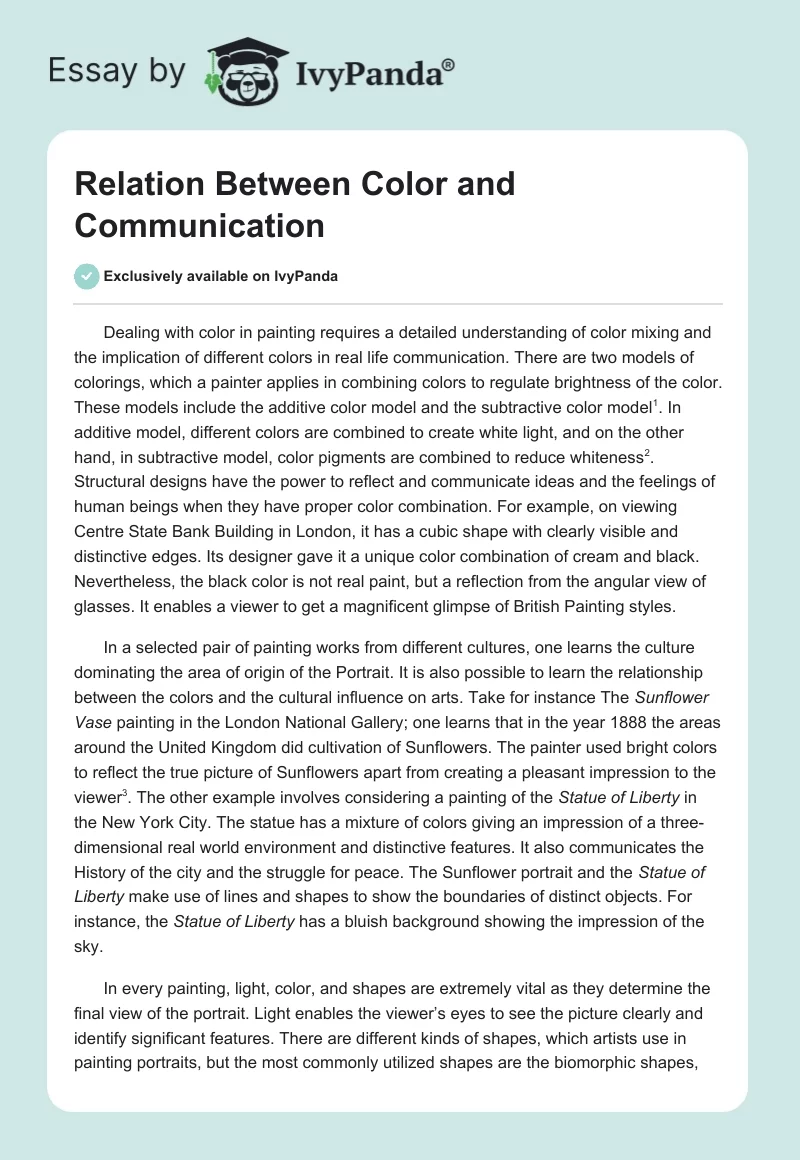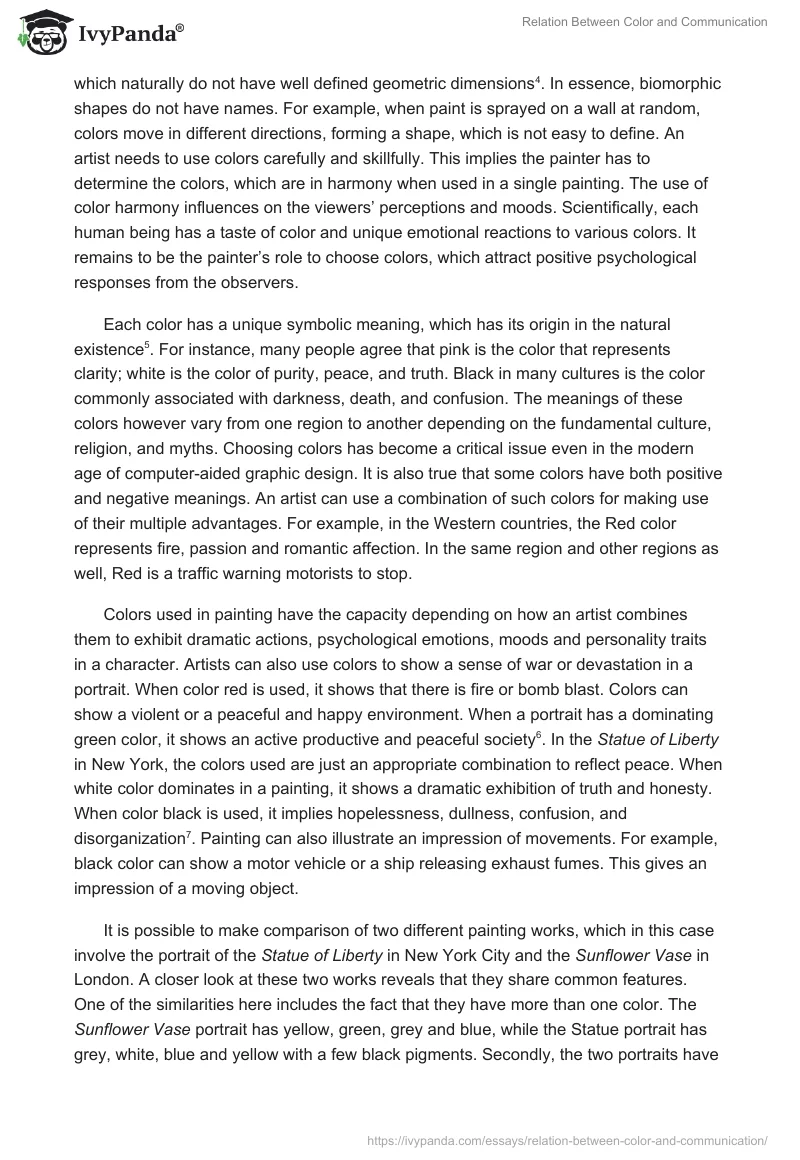Dealing with color in painting requires a detailed understanding of color mixing and the implication of different colors in real life communication. There are two models of colorings, which a painter applies in combining colors to regulate brightness of the color. These models include the additive color model and the subtractive color model. In additive model, different colors are combined to create white light, and on the other hand, in subtractive model, color pigments are combined to reduce whiteness. Structural designs have the power to reflect and communicate ideas and the feelings of human beings when they have proper color combination.
For example, on viewing Centre State Bank Building in London, it has a cubic shape with clearly visible and distinctive edges. Its designer gave it a unique color combination of cream and black. Nevertheless, the black color is not real paint, but a reflection from the angular view of glasses. It enables a viewer to get a magnificent glimpse of British Painting styles.
In a selected pair of painting works from different cultures, one learns the culture dominating the area of origin of the Portrait. It is also possible to learn the relationship between the colors and the cultural influence on arts. Take for instance The Sunflower Vase painting in the London National Gallery; one learns that in the year 1888 the areas around the United Kingdom did cultivation of Sunflowers.
The painter used bright colors to reflect the true picture of Sunflowers apart from creating a pleasant impression to the viewer. The other example involves considering a painting of the Statue of Liberty in the New York City. The statue has a mixture of colors giving an impression of a three-dimensional real world environment and distinctive features. It also communicates the History of the city and the struggle for peace. The Sunflower portrait and the Statue of Liberty make use of lines and shapes to show the boundaries of distinct objects. For instance, the Statue of Liberty has a bluish background showing the impression of the sky.
In every painting, light, color, and shapes are extremely vital as they determine the final view of the portrait. Light enables the viewer’s eyes to see the picture clearly and identify significant features. There are different kinds of shapes, which artists use in painting portraits, but the most commonly utilized shapes are the biomorphic shapes, which naturally do not have well defined geometric dimensions. In essence, biomorphic shapes do not have names. For example, when paint is sprayed on a wall at random, colors move in different directions, forming a shape, which is not easy to define. An artist needs to use colors carefully and skillfully. This implies the painter has to determine the colors, which are in harmony when used in a single painting. The use of color harmony influences on the viewers’ perceptions and moods. Scientifically, each human being has a taste of color and unique emotional reactions to various colors. It remains to be the painter’s role to choose colors, which attract positive psychological responses from the observers.
Each color has a unique symbolic meaning, which has its origin in the natural existence. For instance, many people agree that pink is the color that represents clarity; white is the color of purity, peace, and truth. Black in many cultures is the color commonly associated with darkness, death, and confusion. The meanings of these colors however vary from one region to another depending on the fundamental culture, religion, and myths. Choosing colors has become a critical issue even in the modern age of computer-aided graphic design. It is also true that some colors have both positive and negative meanings. An artist can use a combination of such colors for making use of their multiple advantages. For example, in the Western countries, the Red color represents fire, passion and romantic affection. In the same region and other regions as well, Red is a traffic warning motorists to stop.
Colors used in painting have the capacity depending on how an artist combines them to exhibit dramatic actions, psychological emotions, moods and personality traits in a character. Artists can also use colors to show a sense of war or devastation in a portrait. When color red is used, it shows that there is fire or bomb blast. Colors can show a violent or a peaceful and happy environment. When a portrait has a dominating green color, it shows an active productive and peaceful society. In the Statue of Liberty in New York, the colors used are just an appropriate combination to reflect peace. When white color dominates in a painting, it shows a dramatic exhibition of truth and honesty. When color black is used, it implies hopelessness, dullness, confusion, and disorganization. Painting can also illustrate an impression of movements. For example, black color can show a motor vehicle or a ship releasing exhaust fumes. This gives an impression of a moving object.
It is possible to make comparison of two different painting works, which in this case involve the portrait of the Statue of Liberty in New York City and the Sunflower Vase in London. A closer look at these two works reveals that they share common features. One of the similarities here includes the fact that they have more than one color. The Sunflower Vase portrait has yellow, green, grey and blue, while the Statue portrait has grey, white, blue and yellow with a few black pigments. Secondly, the two portraits have three-dimensional outlook. In both of them, one can easily observe distinct objects right from the foreground to the background. This is because of the use of lines to separate colors and light. Apart from similarities, there is dire need to mention that they have observable contrasts. Of course, the first contrast is in the use of colors.
The artists in both cases have used different number and mix of colors. In the Statue of Liberty portrait, the artist used more colors than in the Sunflower Vase painting. Apart from the colors, the second contrast is in the aspect of brightness. In the Sunflower Vase portrait, the artist used brighter colors than those that were used in the Statue of Liberty portrait. Secondly, the Statue of Liberty shows an impression of action and drama. The most conspicuous object here is the image of a man holding a symbol of peace. In the portrait of Sunflower Vase, there is no sense of action. The artist only creates an impression of elegance and painting skills.
The use of colors, shapes, light, and lines along with the final picture painted on an artwork tells silent stories about the culture of the geographical and historical origin. Culture influences the mindset of every society in a way that only an artwork can express it in details. For example, in a society where cattle rustling is common, artists tend to do a lot of work on the acts around it. In such cultures, the dominating images in portraits show people fighting and scattered in every direction and a sense of movement. In the case of the portraits of the Sunflower Vase and the Statue of Liberty, culture and the place of origin of the images have influenced them such a way that they tell a lot about the culture and the taste of the people in the areas. The flower vase shows that the people in that region in London have an attraction to flowers and perhaps they grow sunflower as a significant crop in their economy. However, in the Statue of Liberty portrait, the artist intends to address the History of Peace Pact, which must be in existence in the New York City. It also displays New York City as a Modern Economy with sophisticated infrastructure.
Indeed, a closer look on the mentioned similar works reveals contrasting features. It is true as illustrated in our cases of the two portraits. It depends on the judgments of the viewer, since analytical work is subjective to different opinions. As it is evident in the two cases, the use of colors in painting results in commonness of pictures no matter how different such paintings might be. Even in cases when artists have used biomorphic shapes, there are similarities in the way they present colors, the number of colors they used and the brightness. Two images may be similar yet again they may convey different messages and represent different cultures. Finally, colors mean different things to different people as has been stated earlier. What the color green means to one culture differs from what it means to another culture. To that effect, there is no absolute similarity between painting works.
References
Berns, Roy. Billmeyer and Saltzman’s Principles of Color Technology. New York: Wiley, 2000.
Bohm-Duchen, Monica. The Private Life of a masterpiece. California: California University Press, 2002.
Gage, John. Color and Meaning: Art, Science, and Symbolism. Berkeley: University of California Press, 1999.
Hirsch, Robert. Exploring Color Photography: A Complete Guide. London: Laurence King Publishing, 2004.
Miringoff, Marque-Luisa, and Sandra Opdycke. Arts, Culture and the Social Health of the Nation. New York: Institute for Innovation in Social Policy, 2005.
Sutherland, Door, and John Berman. The Portraits of America: Statue of Liberty: The Museum of the City of New York. New York: Barnes & Noble Publishing, 2003.


